In this article I’m going to reflect on a photoshoot I recently did while in the woods shooting with my model toad. I found inspiration from the wildlife photography of Petr Babousek. Petr practiced illuminating scenes with artificial lizards and this helped with lighting, composition and camera settings prior to a trip to Madagascar where he planned to photograph a Parson’s Chamelion. This is one of the biggest chameleons encountered in Madagascar and Petr really appreciated his training with toy lizards back in his home. It gave him the confidence to know what camera settings to use and judge just how close he could focus with wide-angle lenses when confronted with a real Chamelion in the jungle. CLICK HERE to see Petr’s incredible wildlife shots.
Of course, the use of artificial models is not restricted to photography. Since the Renaissance it has been common practice for artists and architects to use models to help visualise their final creations. The many exhibited models of the cathedral will strike anyone visiting Gaudi’s Sagrada Familia. Like stepping stones, each model led Gaudi one step closer to materialising his dream. In a similar vein, actors will use props as mimicking aids. In the arms of Fred Astaire a Hat Stand becomes a dancing partner to woo and romance. On a more poignant note, a skull in the hands of Hamlet becomes a ‘momento mori’, a reminder of the fragile and transient nature of life. As human being we naturally project meaning onto objects. For a child, a scribble can be infused with meaning just like a hobbyhorse can become a galloping steed.
Finding a suitable model was the first challenge. For starters, it had to look realistic while also needing to be the same size as the real creature. My first port of call was to scan the Internet for possible models but while I managed to find plenty of amphibians and reptiles, they were either not realistic enough or too small or too large in size. I tried Natural History Museums to see if they had more naturalistic models than the proliferation of toy-like frogs and lizards but this also led to disappointment. Not giving up, I asked my son Daniel if he could laser print a 3D toad. Daniel is a digital game’s artist and runs his own 3D laser printing company so this request was well within his comfort zone. The first model produced was realistic enough but far too small.

Prototype 3D Lazer Print Model of Common Toad only 2 cm long
I asked Daniel if he could do one to scale, using the measurements of a real toad. As you can see, he didn’t disappoint the second model was perfect. I considered whether it would be worthwhile painting skin tones on the model to make it look even more life-like. However, I eventually decided against this as I rather liked its monochromatic, sculptural qualities.
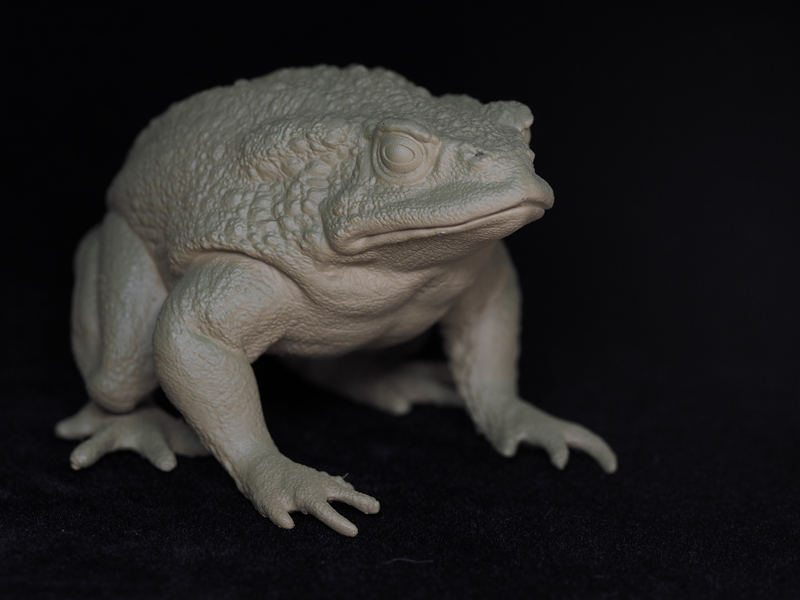
Life Size 3D Model Toad
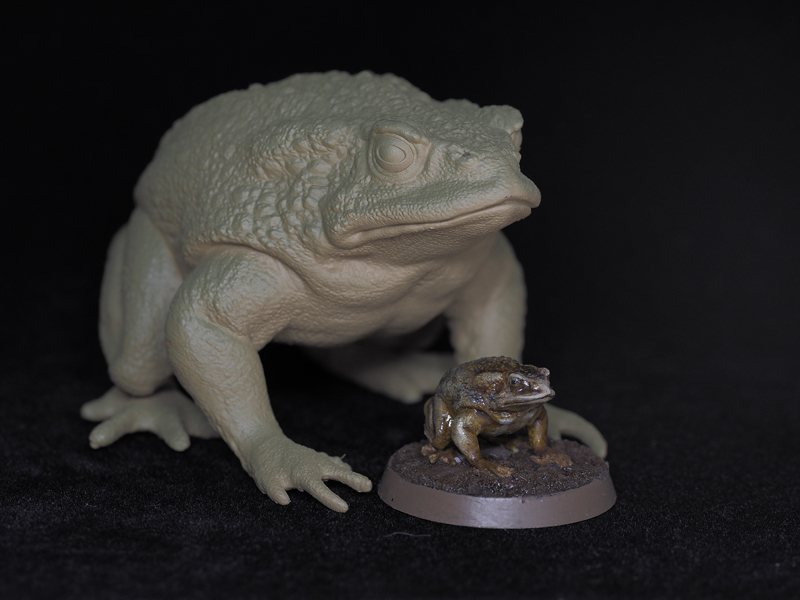
Comparative Size of Models
Having acquired a suitable model I then had to decide where best to photograph it. Somewhere that would provide a suitable natural habitat for toads. Many places sprang to mind but Kenfig Nature Reserve became my first choice. The reserve is one of the last remnants of a huge dune system that once stretched along the coastline of southern Wales from the Ogmore River to the Gower peninsular. Glamorgan’s largest natural lake, Kenfig Pool, is set on the edge of this beautiful sand dune nature reserve. The Reserve is home to a wide variety of rare and endangered species of plants and animals, including the Fen Orchid. Bordering the dune system is an area of marshland surrounded with moss covered willow trees, an ideal habitat for damp loving toads.
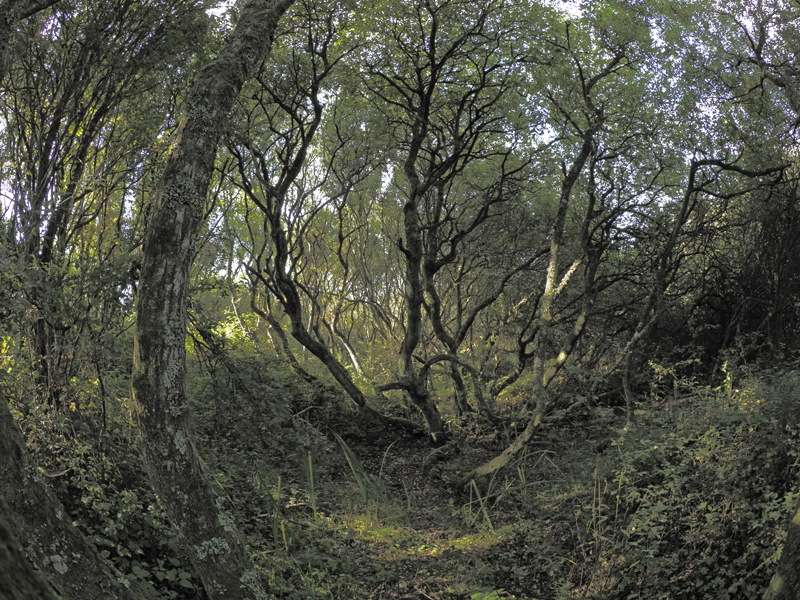
The dark and damp Willow Wood provides an ideal habitat for Toads
Arriving at the reserve I made my way to the willow wood, finding plenty of suitable damp, rotting vegetation on which to place my model toad. Toads will be hibernating at this time of the year so I felt fortunate in at least having an artificial substitute. My reasoning was clear, come the spring when toads, frogs, lizards, snakes and all manner of creatures come out of hibernation, I’ll be ready looking for them and won’t lose the photo due to my own incompetence. A day by the willow wood with my model toad would provide me with a solid foundation for mastering the basics of using wide-angle lenses. It would also give me the opportunity to experiment with my Olympus camera’s focus stacking capability.
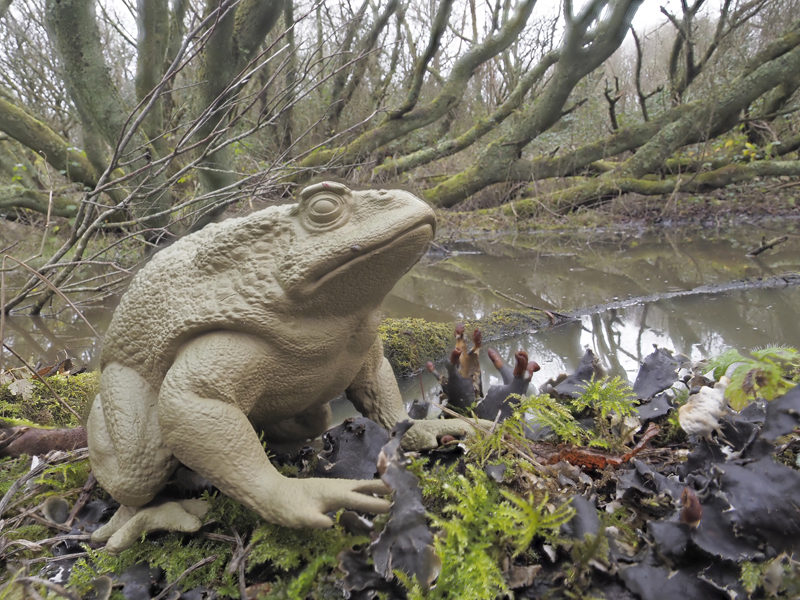
Above: Olympus E-M2 / Olympus 12-40mm f2.8 Pro / 12mm / 1/40 / ISO200 / f4 / 12 stack
Below: Olympus E-M2 / Olympus 12-40mm f2.8 Pro / 12mm / 1/60 / ISO200 / f4 / 8 Stack
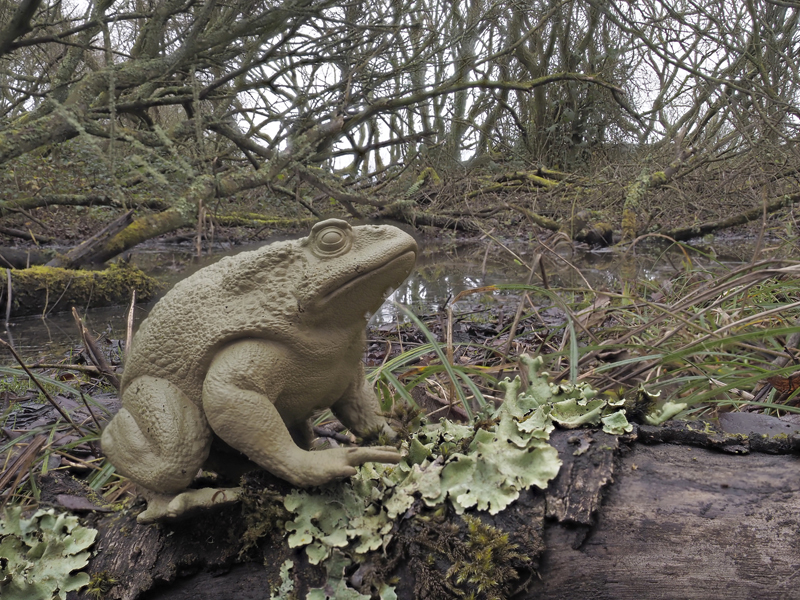
I was in no illusion that inanimate objects would be as difficult or as rewarding to photograph as the real, living, breathing animals. Subjects such as orchids or mushrooms, for example, tend to sit relatively still and unlike amphibians, reptiles or insects will not run away. It’s far more challenging when an animal becomes the object of our interest. Using a wide-angle lens necessitates a close working distance, usually of only a few centimeters, which is exactly the moment when we find out that the creature is not at all interested in cooperating with us. By which time it is usually too late to find out what the best camera settings are, that unique opportunity to take a close-up picture of the animal will have been missed.
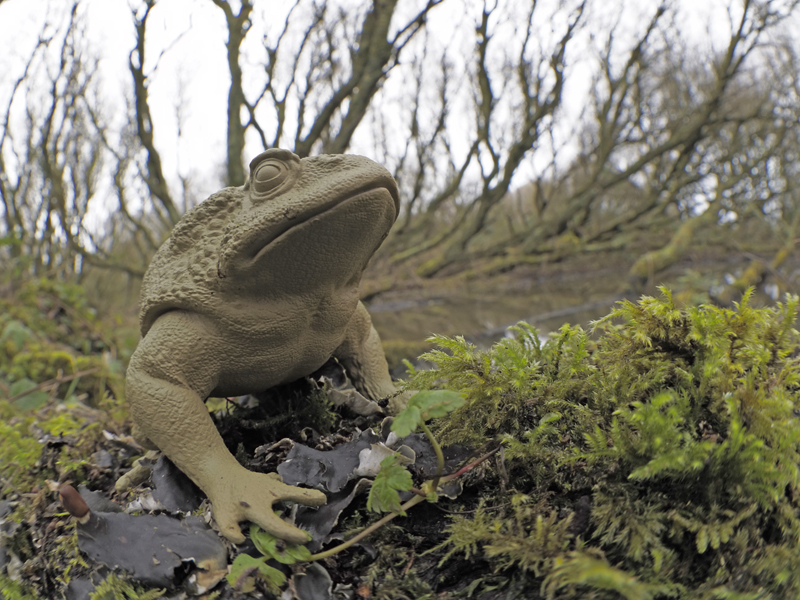
Olympus E-M2 / Olympus 8mm f1.8 Fisheye / 1/20 / ISO200 / f8
With the Fisheye lens I needed to get within a gnats willy of the subject. The fisheye has incredible depth of field so no need to focus stack.
In the pictures below you can see how I composed the various scenes with my artificial toad and how I determined the required working distances for these types of shots. Ironically, due to the bare trees there was more light available on the woodland floor during the winter months than in the summer and no flash was necessary. Come Spring, the tree canopy will start gathering leaves and casting shadows on the ground. The use of flash will then be necessary. This will pose further complications, as I will need to adjust the flash intensity correctly so that the subject will not be overexposed. I’ll also need to position a diffuser correctly so that it does not get in view of the wide-angle lens. This will be particularly challenging with the 180 degrees view of a fish-eye lens that sees everything around it!
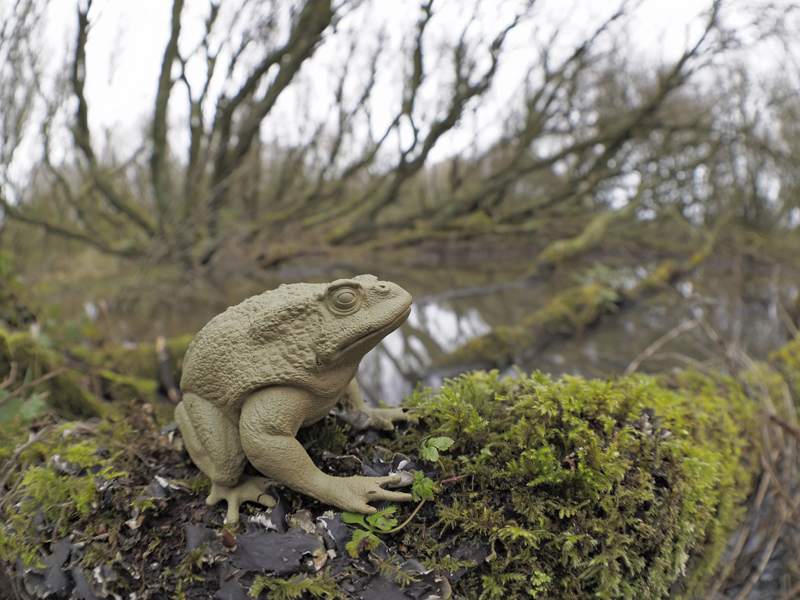
Above: Olympus E-M2 / Olympus 8mm f1.8 Fisheye / 1/60 / ISO200 / f4
At f4 their is a pleasant slight blurring of the background which gives enough indication of the habitat.
Below: Olympus E-M2 / Olympus 8mm f1.8 Fisheye / 1/60 / ISO200 / f4 / 8 Stack
Focus stacking enables the whole of the background to be in focus, ideal for wide-angle environmental shots.
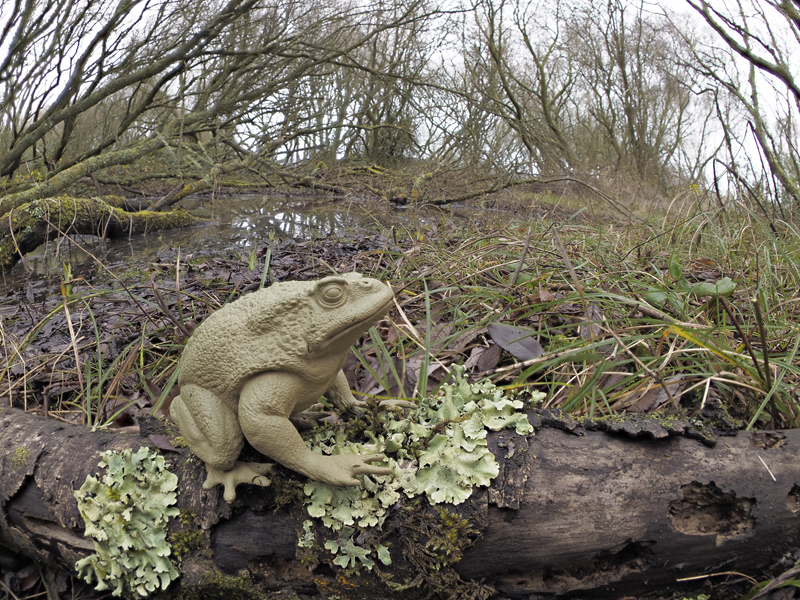
But I’m jumping the gun, I’ll face that problem when I get to it. Or better still, I’ll re-visit Kenfig Nature Reserve with the sole purpose of experimenting with flash and wide-angle. For the time being, I’m pretty pleased with my training shots using my model toad. I now look forward to March when I hopefully will come across real toads.
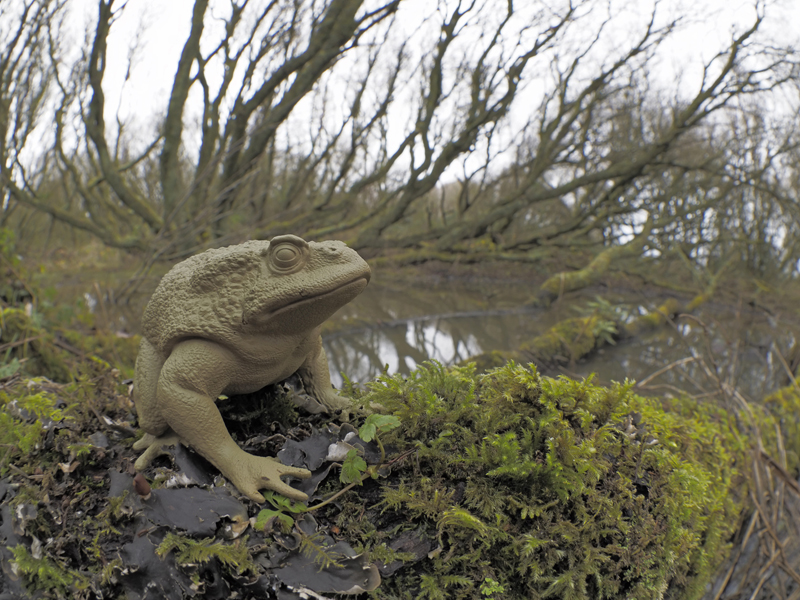
Normally I would shoot a toad with a macro lens in order to isolate it from the background resulting in softly diffused and out of focus background.
However, sometimes it’s good to shoot with a wide-angle or fisheye lens in order to have an animal in context by showing the surrounding environment.
Above: Olympus E-M2 / Olympus 8mm f1.8 Fisheye / 1/20 / ISO200 / f8
Below: Olympus E-M2 / Olympus 8mm f1.8 Fisheye / 1/15 / ISO200 / f8

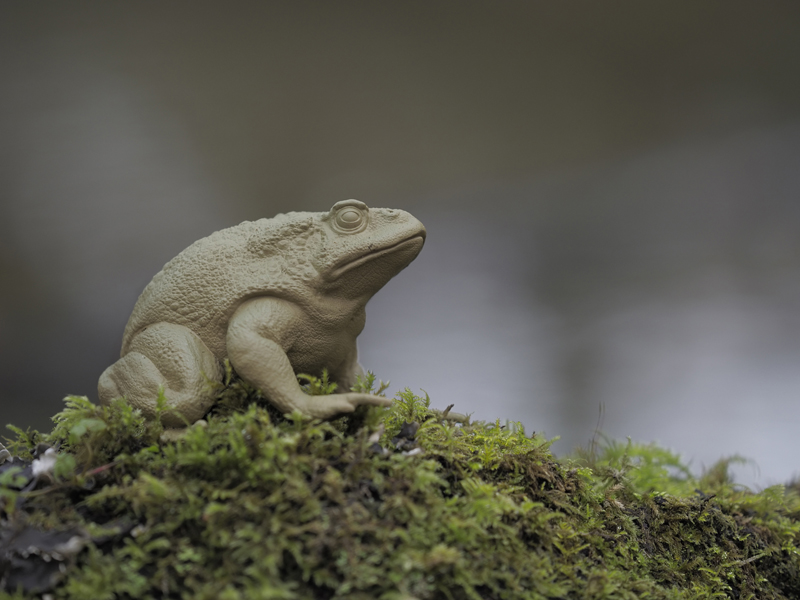
In contrast to the wide-angle environment shots featured in this article here the classic telephoto focuses on the toad while diffusing any notion of background detail.
Above: Olympus E-M2 / Olympus 40-150mm f2.8 Pro / 150mm / 1/200 / ISO200 / f2.8
Below Olympus E-M2 / Olympus 40-150mm f2.8 Pro / 150mm / 1/160 / ISO200 / f2.8


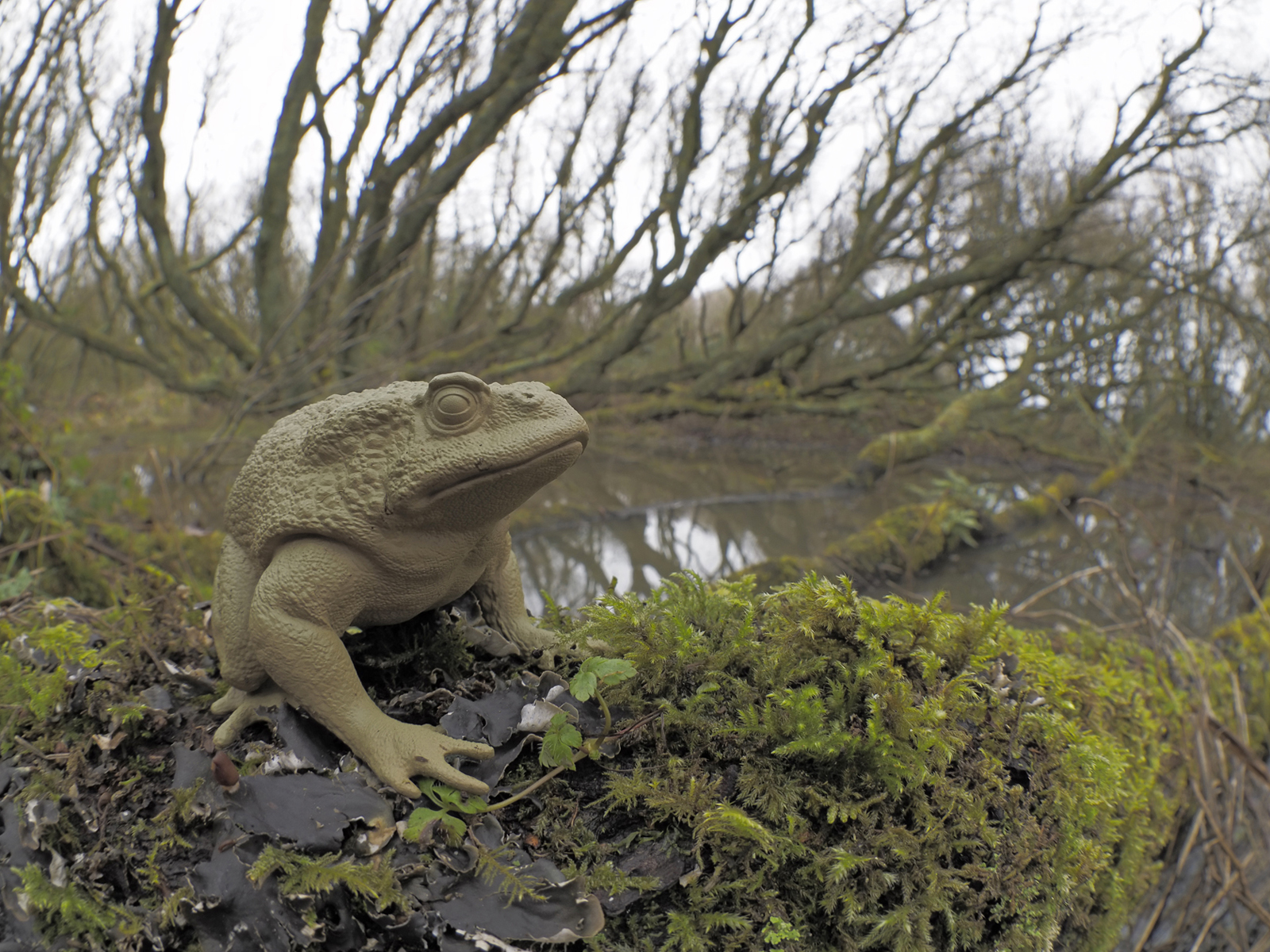
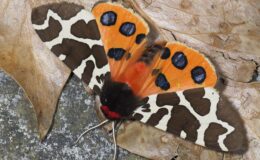
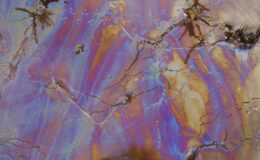
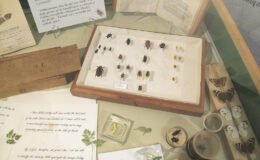
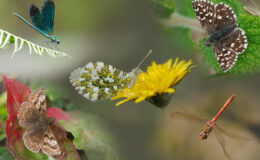
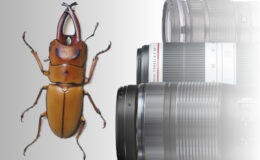
Leave a Comment